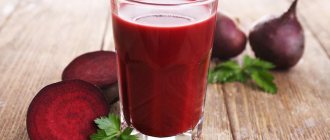Today, many mothers, for one reason or another, do not have the opportunity to breastfeed, so the problem of creating the right diet for the baby is urgent for them. This question becomes especially important by the age of 7 months, when the baby’s mental and physical activity sharply increases: the baby is already sitting, perhaps crawling, or even standing on his legs, holding onto a support. There is an intensive process of learning about the world.
At this age, the child's body expends a lot of energy. To make up for it, the child needs a full menu that will bring him maximum benefit. In order to create an approximate diet for a child at 7 months, you need to figure out which foods are mandatory for him.
Differences in the introduction of complementary foods during breastfeeding and artificial feeding
The menu for a 7-month-old baby who is bottle-fed (IV) has a much greater variety of products than the menu for a 7-month-old baby who is breastfed (BF). This is not surprising, because nursing mothers introduce the first complementary foods to their child much later - at about 5-6 months. For such children, mother's milk is the main component in the daily diet.
Artificial babies are introduced to complementary foods much earlier. This is necessary to replenish those essential substances that are in breast milk, but not in formulas. In addition, due to the formula in such children, the digestive system begins to adapt to the intake of adult food earlier, and therefore problems in the form of an allergic reaction at this age are less likely.
So, what foods can you feed a seven month old baby if he is growing up on formula:
- porridge with water or mixtures (gluten-free);
- fermented milk - cottage cheese and kefir;
- meat puree:
- egg yolk;
- vegetable and fruit puree;
- juices and compotes;
- cookies, drying, crackers.
Based on the total amount of food, the daily amount of food for a 7-month-old baby is 1/8 of his weight. The resulting number must be divided by the number of meals (at this age 5 times) - this is the norm for feeding the baby once. This necessarily includes formula feeding.

What can you feed a baby at 7 months?

Now we have come to the most important question. At the age of seven months, absolutely all children have a varied menu. However, it still differs in its composition.
Naturally nourished baby
At the age of seven months, porridge (but only representatives of the gluten-free range), fruit purees, compotes and juices are added to the baby’s diet. It is already allowed to sometimes add a little butter (butter) to the prepared dish. But you should still avoid salt and sugar.
Now you can introduce new types of vegetables, buckwheat, rice porridge, fruits. The main thing to remember is that the baby still needs food of a liquid and uniform consistency. We are still introducing new products a little at a time and monitoring how the child’s body reacts.
As for juices and compotes, prepare or buy them based on products to which the child’s body has already adapted. And it is important to know that juice prepared at home must be diluted by half with special baby water.
I first introduced apples and pears to my toddler at this age. And the first drinks I gave were clarified apple and pear juices. The first of the porridges was buckwheat, cooked in water (it was still too early to cook with milk). The baby liked the new products and, fortunately, was accepted normally by the body.
Baby with artificial feeding
The artificial baby's menu is already quite varied. It includes many products. Vegetable purees, cereals and fruit purees remain irreplaceable. If you haven't yet introduced egg yolk, fish and meat, now is the time. It is important to remember that the portion of food for such children should be one and a half times larger than for those who are breastfed. The food intake can be calculated as an eighth of your child’s body weight.
Rules for introducing adult food
The appropriate time for introducing complementary foods should be determined strictly individually, depending on the child’s condition. Before doing this, you should definitely consult with the doctor observing the baby.

The health of her baby depends on the mother’s responsible approach to this issue. It is important to adhere to simple rules for introducing complementary foods, which will be relevant throughout the entire period of introducing new types of foods into the diet.
- A new product should be introduced very carefully, starting with half a teaspoon. If there is no allergic reaction, then after two weeks the baby can eat the full portion corresponding to the norm for this age. One feeding of a child at 7 months consists of approximately 200 grams of food. Based on this, the volume of one specific product should be calculated.
- You cannot give two or more new types of foods at the same time, since in the case of an allergy it will be difficult to determine what exactly the child reacted to.
- At seven months, the baby is actively teething, which may be accompanied by an increase in temperature, loose stools and other “delights”. Therefore, mothers are strongly recommended to stick to their previous diet during this period without introducing anything new. The same can be said about the timing of routine vaccinations.
- A baby's food at this age should have the consistency of a puree, which can be obtained using a blender or strainer. But if sometimes small soft pieces come across, then it’s okay. The child should gradually get used to coarser food.
- It is advisable to give new food in the first half of the day, during which the food reaction can be monitored.
When introducing foods, you should try to maintain the same diet typical for 7 months of age. You should not overload the baby’s stomach at night - it is better to feed him with formula in the morning and evening to relieve digestion after hard work.
Some mothers want to switch their child completely to adult food as soon as possible. This should not be done under any circumstances, since infant formula still remains the main source of beneficial nutrients and vitamins. Depending on appetite, the baby is fed it 2-3 times a day or even more. Regular food at this stage is still only an addition to the main diet.
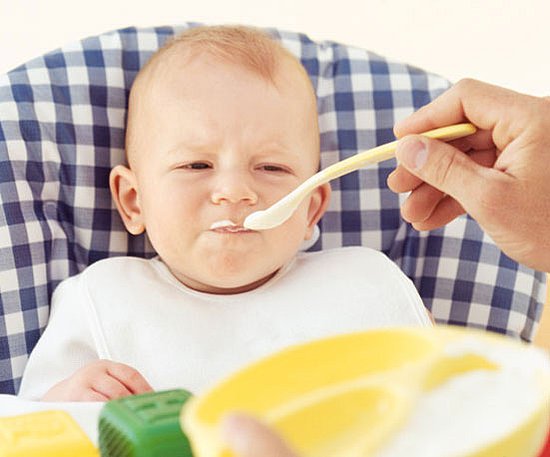
What vegetables do seven-month-old babies need?
A growing body needs valuable vitamins, which are found in fresh vegetables and fruits. By introducing certain foods into a child’s diet, the child’s health can be significantly improved, and in some cases, certain disorders can be corrected. For example, if a child begins to suffer from severe constipation, then it is recommended to give him boiled beets in small portions, which must be chopped on a very fine grater. The beets are seasoned with a small amount of vegetable oil and given two or three teaspoons before lunch. You can also give a little prune puree, as it has the same properties as boiled beets. Do not forget that prunes can only be given if there is no allergy. One of the easiest and most easily digestible vegetables for a child’s body is pumpkin and puree. By regularly eating these foods, problems with intestinal functioning are solved. These vegetables contain large amounts of vitamin A and are very beneficial for a child's vision. At seven months, beans and peas are allowed to be introduced into the child’s diet, but in small portions and gradually. After they are given to him, you need to carefully monitor the baby’s reaction, since despite all the benefits, they can provoke the appearance of severe colic and have a negative effect on the condition of the intestinal mucosa. Cauliflower is very useful for a small child, as it contains a large amount of vitamins and is not capable of causing bloating. Cauliflower should be given boiled and chopped in a blender, since small children cannot yet chew food on their own. At an older age, you can give foods not in the form of purees, but in small pieces.
A bit of ethics
The child is growing before our eyes. At the age of 7 months, active cognition of the environment begins. Looking at the parents, the baby learns how to behave in society. Therefore, it is important to instill in him useful skills and good manners from an early age.
- The child should eat in a sitting position. For their child, parents can purchase a special feeding table that meets safety requirements. This table is very convenient not only for the baby, but also for his mother.
- It is necessary to feed with a spoon. If a child takes a spoon from his mother to “work” with it on a plate, do not interfere with him. This way he will gradually develop his hand and learn to eat on his own.
- If the baby wants to familiarize himself with the contents of the plate in the traditional way for children, do not interfere with him. Food-stained walls are an integral attribute of the presence of a child in the house.
- There is no need to force feed, against your will. It’s better to keep the child busy and put a spoon in his mouth between times than to try to achieve this through screaming and crying.
- You should personally set an example of table manners.
READ ALSO: Menu for a 4-month-old bottle-fed baby: what can you give your baby?

Porridge is our strength
Porridge for a 7 month old baby is the main source of carbohydrates. At this age, he has probably already become acquainted with gluten-free cereals, which are healthy at any age. What kind of porridges are cooked from these cereals:
- Buckwheat is the main source of iron and other trace elements. The kids always like it.
- Rice - contains not only proteins and vitamins, but also envelops the walls of the stomach and intestines, protecting them from irritation. Good for infants with loose stools.
- Corn is one of the main products for allergy sufferers; it contains iron, potassium and other beneficial substances. It is a good prevention against constipation.
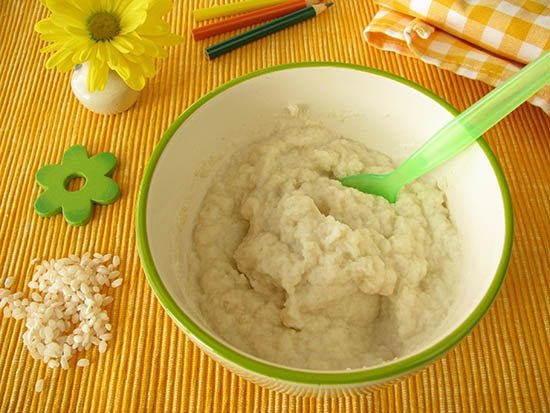
These cereals should be on the menu of every bottle-fed baby at 7 months. They are hypoallergenic. They can be boiled in water, vegetable broth, or followed by the addition of a mixture.
Russian pediatricians agree that gluten-free cereals should be introduced to children after 1 year of age. The only exception is oatmeal, famous for its beneficial properties. It, like all new products, should be introduced carefully, without haste. You can add a little bit to the main cereals, gradually bringing it up to the age norm.
What, how much and when?
The feeding regimen for children over 7 months of age includes 5 meals a day. A distinctive feature of nutrition is the formation of meals that correspond to future full breakfasts, lunches and dinners.
Day after day, new products are replacing mother's milk, which is now given only in the morning and before bedtime.
Intervals between feedings of 4 hours correspond to the physiological capabilities of the child's body, without causing discomfort from the digestive system.
Existing food consumption standards are offered by pediatric nutritionists as recommendations. But the amount of food eaten largely depends on individual characteristics:
- constitutions;
- speed of metabolic processes;
- physical activity.
An approximate diet for a child during the 7th month of life is presented:
- breast milk or infant formula;
- vegetable puree;
- porridge (milk or vegetable broth);
- egg yolk;
- cottage cheese;
- meat puree;
- canned or freshly prepared fruit purees and juices;
- kefir;
- crackers (cookies or crackers);
- bread.
The method of calculating the total amount of food used by pediatricians is called “volumetric”.
It is quite simple: a child of 7 months should receive a daily amount of food equal to 1/8 of his weight. For example, a baby weighing 8 kg needs 1 kg of food, taking into account the milk base in the form of mother's milk or infant formula. Having divided the daily amount of food into the number of meals, we focus on the volume of one feeding: 1 kg/5 = 200 g. The increased need for energy with increasing physical activity is also reflected in the ratio of carbohydrates, proteins and fats (CPF) in the diet - 4:1:1 , and the daily calorie content is 110-115 kcal per 1 kg of body weight.
There is a classic order of introducing complementary foods to the menu of a 7-month-old child: vegetable purees, after a month porridge is offered, after 2 weeks - egg yolk, butter, cottage cheese, meat, and closer to 8 months of age - kefir.
Menu for an 8-month-old bottle-fed baby.
Vegetable puree is a source of fiber
Along with cereals, it is one of the first complementary foods for infants. A child at 7 months should continue to receive vegetables as an irreplaceable source of fiber, beneficial for every tummy. Vegetable purees are easily digestible and do not have an irritating effect on the intestines.
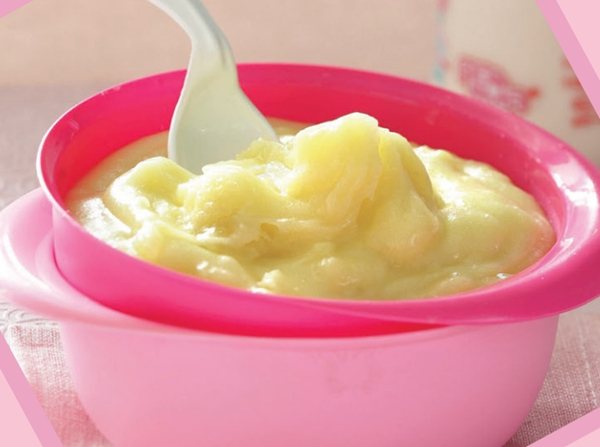
Before six months, the baby has already tried zucchini, cauliflower and broccoli - leaders in baby food. Now he can be offered carrots and pumpkin - sources of retinol (vitamin A). A little later - try potatoes, but only a little at a time, as they strengthen the stool. By 8-9 months - corn puree, very tasty and sweet.
You can mix vegetable purees with a small amount of pea and bean puree - sources of vegetable protein. It is better not to offer them individually, as they are known digestive irritants. But in combination with vegetables they are absorbed quite well.
You can add half a teaspoon of vegetable oil (sunflower, corn, olive or flaxseed) to the puree. A small pinch of salt, literally a few crystals, is allowed.
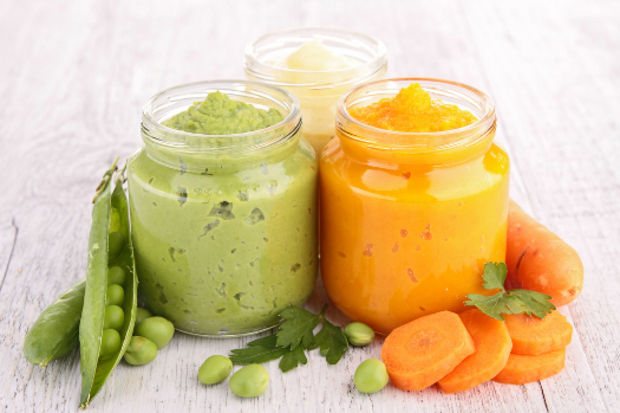
What should be on the menu at 7 months
Complementary foods should always be introduced in small portions and very carefully. Firstly, the child may be allergic to any product. And secondly, he himself still needs to get used to the fact that, in addition to mother’s milk or formula, there are many other tasty dishes. A 7-month-old child's menu must include a variety of cereals, soups, vegetable and fruit purees, berries and compotes.
Porridge should always be prepared from different grains so that it is not repeated day after day. The most useful are buckwheat, millet and corn. While semolina and oatmeal will contain the bare minimum of nutrients. Using a nibbler, you can let your child taste fresh berries and fruits a little at a time. This simple device will free your hands and protect surrounding objects from your baby's sticky hands.
For vegetables, feel free to use carrots, cabbage, zucchini, pumpkin, just remember that although potatoes should be present in the child’s menu, they cannot be made the main ingredient of dishes, i.e. use them to a minimum.
Grind all the ingredients with a blender, so it will be easier for your baby to swallow them.
Meat is a must
The menu of a 7-month-old child should contain a meat dish every day. Meat is a source of protein and iron, which is necessary to prevent the development of anemia. Turkey, rabbit, veal (lean beef) are suitable for this age. You can try chicken, remembering that it is an allergenic product. Other types of meat are heavy food for the baby, for which he is not yet ready.
At home, the meat should be thoroughly boiled and then chopped using a blender. If a child suffers from allergies, it is recommended to boil the meat twice, draining the primary broth. When preparing puree, it is recommended to add water or meat broth to it so that the consistency becomes semi-liquid.
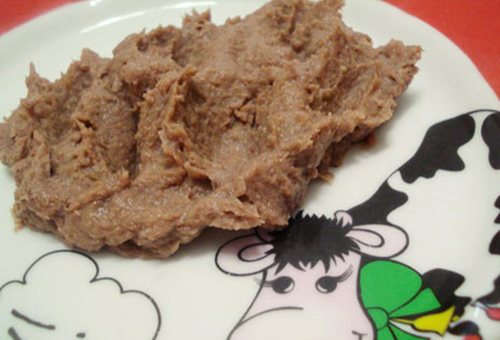
It is permissible to mix vegetable and meat purees - the baby will certainly like this dish. Or you can cook light soups in broth with the addition of a small amount of cereal. This will diversify the baby’s diet and teach him to eat proper lunches.
Egg yolk for the prevention of rickets
To avoid an allergic reaction, pediatricians often prescribe quail egg yolk for complementary feeding to infants. If there is no reaction, then you can smoothly switch to the yolk of a chicken egg. Protein up to a year is not recommended, as it is considered a strong allergen.
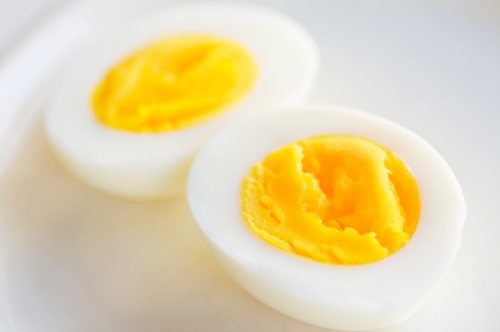
The egg must be hard-boiled (about 10 minutes) - soft-boiled or in a bag is prohibited for small children. The baby only needs to boil a fresh egg. To distinguish fresh from stale, just put it in water: in the first case, it will immediately sink, and in the second, it will float.
Egg yolk is unusually rich in vitamins and minerals. It is most valued for the presence of vitamin D3, which prevents the development of rickets in infants. The yolk also contains potassium, calcium and phosphorus, which are necessary for the growing body to strengthen bones. Vitamins include retinol (A), tocopherol (E), niacin (PP), as well as some B vitamins.
It is advisable to introduce this product to IV children at approximately 5-6 months, and for breastfeeding children at 8-9 months. To do this, divide it into eight parts and give one part mixed with porridge or vegetable puree. At seven months, you need to distribute two chicken yolks per week, that is, you can give the child about 1/3 of a yolk or ½ of a yolk 3-4 times a week per day.
READ ALSO: How to prepare compote for an infant
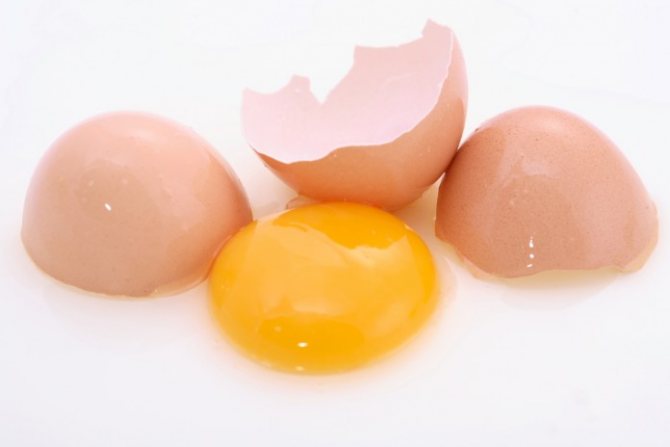
Dairy products
A child's diet must include fermented milk products. For children under one year old, these are cottage cheese and kefir. These products are rich in calcium, minerals and protein.
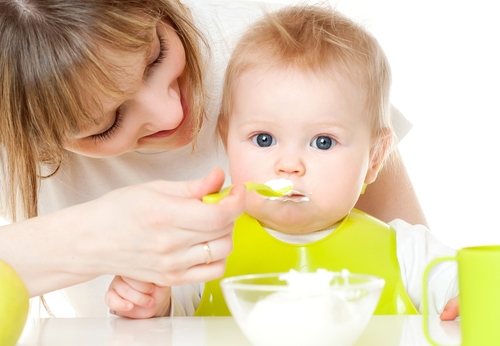
It is recommended to introduce fermented milk at 7-8 months, since at an earlier age, excess protein can disrupt kidney function and metabolism. Excess calcium in the body can contribute to the early closure of the fontanel.
These products are quite heavy for children’s digestion, so their daily norms are relatively small: for cottage cheese - no more than 30 grams, and for children’s kefir - about 100 milliliters. For the first time, both products should be introduced, starting with half a teaspoon, gradually increasing to the daily norm.
If a child has developed an allergy to fermented milk products, the entire dairy diet containing cow's milk protein, including butter, should be discontinued.

How to introduce vegetables into your diet
It is very important to remember that new foods should be introduced into a small child’s diet gradually and in small portions. It is necessary to monitor the child’s reaction in order to determine his taste preferences. It may be possible to find vegetables that he enjoys eating without his parents having to force food into him. To ensure that a small child receives as many valuable vitamins as possible, parents can cheat a little and mix vegetables with foods that he loves, but add them in small portions. If a child becomes allergic to a particular vegetable, it is necessary to remove it from the diet and try to introduce it at an older age.
Butter - to improve taste
If you are not allergic to lactose, in the seventh month it is very good to add about half a teaspoon of butter to the porridge. When purchasing it, you should pay attention that it is oil and not a spread. It should not contain vegetable fat.
If your baby has lactase deficiency, you need to check that the package says “sour butter.” This means that it is made from fermented cream, which means that with this technology, milk sugar is broken down, which is exactly what is required if there is a lack of lactose enzyme in the body.
Fruits and juices: their benefits for babies
Every little child loves to drink juice or eat fruit puree. This is not surprising, because fruit is a dessert for kids. They are an excellent source of all the vitamins necessary for a growing body.
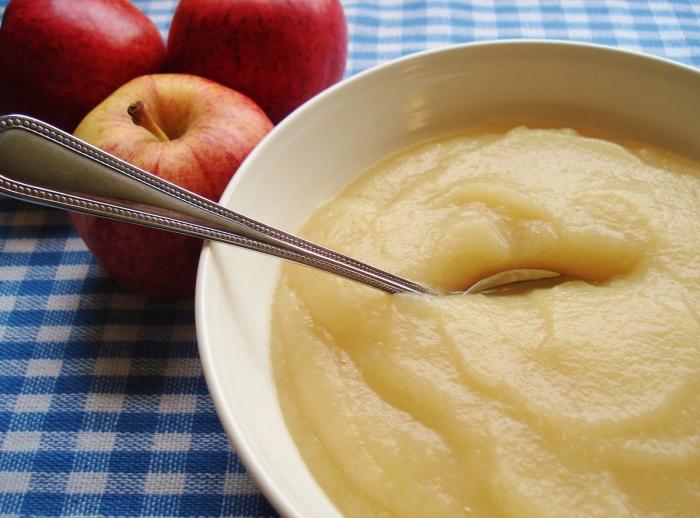
By seven months, an artificial baby is most likely already receiving apple, pear and banana purees - these fruits are ideal for the first year of life, as they improve cardiac function and increase iron levels in the blood. If the time of year allows, you can try giving a peach or apricot. It is not recommended to give imported fruits and berries, as they may be treated with preservatives, to which the baby may have an allergic reaction.
At this age, it is allowed to give the baby juices - apple and pear. At an earlier age, this should not be done, since the fragile intestines can be severely irritated by the acids contained in the juices. Start adding juice from half a teaspoon, after diluting it with boiled water in a 1:1 ratio, and bring it to a volume of 50-60 milliliters.
At this age, juices can be given separately or served with porridge. You can cook compotes, which are also loved by all children.
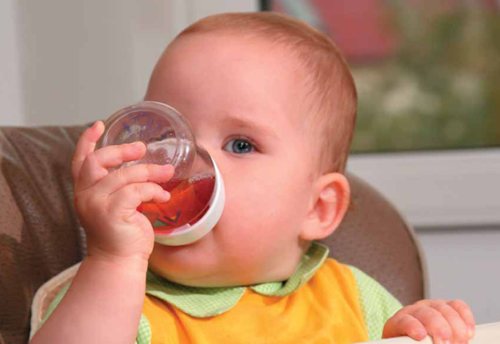
What kind of cereals can a 7 month old baby eat?
Preference is given to rice, buckwheat, and corn cereals, since they are low-allergenic, do not contain gluten, are easily digestible, and also supply the growing body with slow carbohydrates and B vitamins. Slowly digested and absorbed, they maintain a long-term feeling of satiety.
In this case, the “first” porridge for a child should be one-component and liquid. Only after its successful introduction into complementary foods should some other ingredients be added. This way, it will be easier to identify which product the baby will have an allergic reaction to. In this case, you can prepare porridge yourself or use ready-made offers.
For preparation, they use this method: grind the cereal before cooking or grind the already prepared porridge with a blender. It is diluted to the required consistency with vegetable broth, formula or breast milk.
You can calculate the volume of ingredients to create porridge by measuring the required amount of cereal with a spoon:
- To make the porridge 5% liquid, take 1 small spoon of cereal per half a glass of water.
- After a couple of weeks, you can switch to 10%, adding 1.5 tsp to the same volume of water. cereals
- A new dish for a baby is introduced from a small spoon. Portions, if well tolerated, increase every day, reaching 150 g by the end of the 2nd week and completely displacing breast milk from one feeding. The ideal time to eat is 10 a.m. for second breakfast.
Feeding regimen for a 7-month-old bottle-fed baby
The menu for a breastfed baby at 7 months contains less variety of products than for their bottle-fed peers. So, now knowing what a seven-month-old baby can and should eat, as well as his approximate daily routine, you can create a daily diet for him.
| 6.00 | Mixture |
| 10.00 | Porridge 170 gr. + butter 5 gr. + ½ chicken yolk + fruit puree 30 gr. |
| 14.00 | Minced meat 30 gr. + vegetable puree 150 gr. + vegetable oil ½ tsp + fruit juice – 60 ml. |
| 18.00 | Cottage cheese 30 gr. + cookies 5 gr. + fruit puree 50 rub. + mixture |
| 22.00 | Mixture |
This table displays an approximate child's menu for one day. It is listed in some children's medical records. If desired or necessary, products can be added or removed every day.
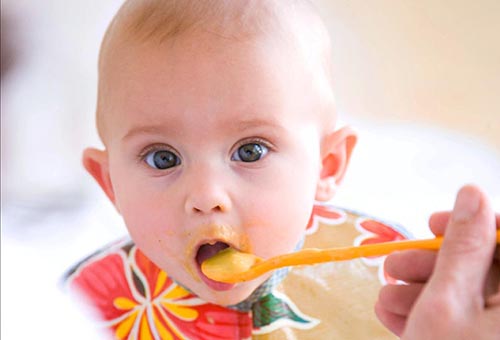
If the child does not get enough to eat, it is allowed to increase the single serving or add one feeding. For any questions regarding diet, please contact your pediatrician.
Feeding: when, how much and what?
So, what to feed a 7 month old baby? The feeding regimen for babies of this age includes five meals a day. The main feature is the formation of meals corresponding to full future breakfasts, lunches and dinners. Day after day, new products replace mother's milk, which is now given exclusively before bedtime and in the morning.
Between feedings, intervals of 4 hours correspond to the physiological capabilities of the child’s body, without causing discomfort from the gastrointestinal tract. There are certain norms for food consumption. At the same time, the amount of food eaten depends largely on the characteristics of the baby:
- speed of metabolic processes;
- constitutions;
- physical activity.
Let's figure out what to feed a baby at 7 months. An approximate diet for a baby is presented:
- Vegetable puree.
- Baby formula or milk.
- Egg yolk.
- Porridge (vegetable broth or milk).
- Meat puree.
- Cottage cheese.
- Kefir.
- Canned or freshly prepared fruit puree (a child at 7 months can also be given juices).
- Bread.
- Crackers (dryer or cookies).
So, what should you give your baby at 7 months? There is a traditional order of introducing complementary foods: vegetable purees and cereals are offered at 6 months during breastfeeding, earlier during artificial feeding, after 2 weeks alternately - yolk, kefir, butter, meat, after 8 months - cottage cheese.

